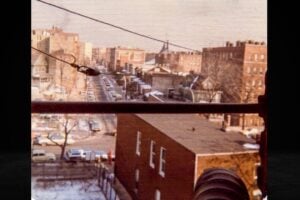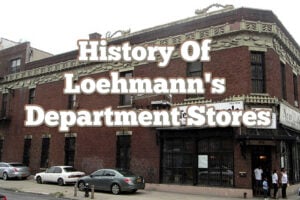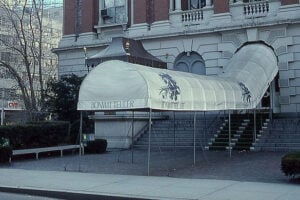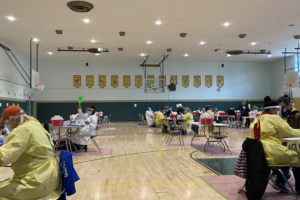
Photo: Levittown houses. Mrs. Rose Sagistano, residence at 3635 Regent Lane -Gottscho-Schleisner Collection / Public domain
Giving the public what they need at the right place, the right price, at the right time is the secret to business success. In 1945, with the end of World War II, many New Yorkers, servicemen and women, were coming home to their loved ones and trying to restart life as they knew it prewar. Some were already married with spouses living with relatives or getting by in small apartments, so when the family was reunited in peacetime it was time to get serious about really “settling down”. The tri-state area, New York, in particular, was full of veterans with young families searching for affordable accommodations. With the stream of returning military personnel, demand far outweighed supply for housing.
Along came savvy builder, William Levitt, son of a real estate attorney and investor, Abraham Levitt. Born in Brooklyn, William Levitt, along with his brother Alfred, an architect, who oversaw the design end, helped expand the family business by overseeing the building of many upscale homes in Long Island, which was steadily growing in population. When World War II broke out, he took time out to do his duty in the Navy, but coming home from the war, he saw up close and firsthand the hard time his fellow vets had in finding a place to live. He also saw a fabulous money-making opportunity as he had more than enough eager customers for his product: an affordable starter home!
Levitt made some fast, calculated moves to plan his suburban utopia. First, he bought 20 square miles potato fields originally listed as “Island of Trees” in deeds during the Colonial times. (The land had originally been purchased by a wealthy settler, John Seaman in a trade with the Massapequa Indians. The trade was called the “Jerusalem Purchase”.) Seven miles was dedicated to the first wave of 2,000 homes and then built 4,000 more. Most were in the Cape Cod-style, but later ranch style homes were added. Then Levitt and Sons looked at how fast they could build the most homes, in the most efficient manner, in the cheapest way possible and still offer an attractive, functional, home at a price point that a young family could afford.
The old way of building homes was one at a time, including digging out a basement and painstaking headaches with finding material vendors, paying workers high wages (often time due to union contract) and dealing with finicky customers dictating showy demands. Young couples, the parents of the post-war “baby boomers” weren’t so fussy. They wanted a safe, secure place to live.
Levitt bypassed all the bells and whistles of fancy home building for his new community, originally called “Island Trees.” He took a cue from the auto industry and invented a new way to build, assembly-line style! That meant constructing residences at the rate of 30 houses per day.
The first obstacle was getting permission to build houses without a basement. This was unheard of, a radical proposal! Still, Levitt got his motion passed at a zoning meeting to skip the basement and build these homes right on a concrete slab. The houses were all uniform with some variations, like the color but all had the same “plan.” The kitchen was built adjacent to the bathroom so it could share plumbing. Each lot was a quarter acre with a slate walkway. No fancy garages or frills. Just basic houses with what a family would need to call “home.”
The materials, bought in bulk, were delivered right to the site. It helped that the Levitt family owned a lumber yard on the west coast! The teams of masons, carpenters, electricians, and plumbers all added their pieces in record time. The labor was all nonunion, as Levitt and Sons were committed to keeping costs down. With so many tradesmen coming back from the war without jobs, and union work hard to get, many vets jumped at the chance for work. And work they did…to build a community of homes, the first planned suburban community using a formula of 27 precision steps from breaking ground to finish.
Veterans and their families waited on lines for hours just for the chance to sign up to move to Island Trees. Half of the homes already had rental agreements in place pre-production. Originally conceived as rentals, they soon gave residents an offer they couldn’t refuse. Low money down, as little as 400 dollars, and a mortgage that was far less than the rent they would pay in the city. Using the G.I. Bill homeowner assistance benefit, the first homes sold for under $8,000, and came with a television!
The first wave of families moved into over 1,000 homes as early as fall 1947 through 1951. The homes had everything a family could want, a nice size quarter acre lot, a fully equipped kitchen, and each home came with a washing machine! It was heaven. Although the earliest residents say that their “yard” was a muddy soup when they moved in, soon the rich fertile land sported fresh, green lawns and shrubbery. There was a strong sense of neighborhood pride, and using push mowers, they manicured the grass and planted rose bushes to keep the area beautiful. In addition to Jerusalem Avenue, all the streets had sweet-sounding names like Mallard, Lilac, Maple, etc. Residents say they would sometimes get lost on their way to their own homes, as used to living with numbered streets, this was an adjustment.
In the earliest days, there were no neighborhood stores, but no matter, Mr. Levitt made sure the shopping came to the community. Older residents who were there for the first wave say that a dairy truck meat truck and produce truck made weekly visits to serve the homemakers. This was a convenience because back then most families only had one vehicle, and the vehicle went to work with the family breadwinner. Many homemakers didn’t even drive, especially those transplanted from the city where public transportation made having a car to use was a luxury, not a necessity.
The early “settlers” got a chance to vote to keep the community name of “Island Trees” or simply call it “Levittown” after the builder. Some say every vote was counted but others claim the fix was in to flatter the founding family by naming it after them. Whichever way it went, Levittown was the place to be for vets and their growing families.
What was daily life like for the earliest Levittown families? According to friends I have spoken with and Facebook groups dedicated to the memory of the first planned suburb, it was a baby boomer’s paradise. Fenced in yards were not permitted until 1957, and kids would just travel from yard to yard, playing games and riding their bikes down each other’s streets. Moms took turns minding the neighborhood kids as well as relaxed for kitchen coffee klatches and canasta games.
On weekends, the families would get together for barbecues and the suburban version of a block party, with drinking and dancing, while they took turns checking on the kids. No one had the money to hire a babysitter and go out, but still, there was fun galore to be had right in the neighborhood. Each family loved to entertain and were able to whip up amazing family dinners and party food, all with what we would now call a sub sized refrigerator and three burner stoves! If you visit the Levittown Historical Society Museum Facebook page, you can see some interesting photos and get a glimpse of how the residents still celebrate being the first-ever planned suburb! There are also a few groups on social media where those who grew up there share their fond memories and photos.
And of course, there was Cosmo the Ice Cream Man who had kids running to get pocket change every time he’d come around. Much like our Mister Softee truck in the Bronx, but Levittown was more personal, more of a “community.” However, progress marched on and soon the area became “built up”.
In 1953, Levittown got its first shopping center, or mini-mall, with a Woolworth’s, J.C Penney, and an A&P. Politicians like John F. Kennedy made a stop at Levittown’s Shop-O-Rama, on his campaign trail. A community pool was added, which took the place of the small, circular pools placed in individual yards. The neighborhood pool for residents only became the social hub during the summer months. Swimming lessons were offered to kids whose parents had to settle for jumping into open fire hydrants to cool off in the sweltering summer.
Life was changing and getting better economically and socially for these families, with a new emphasis on children’s health and happiness. Child psychologists published books that encouraged parents to give their children lots of attention and material benefits. Unfortunately, the area was segregated and remained so for decades. Unlike their parents, Levittown born children did not receive the benefits of growing up in a diverse neighborhood, nor could African American veterans buy or rent a Levittown home. Yes, it was an area critics dub as a suburb of white privilege and shameful prejudice.
Schools with names like Island Trees provided plenty of after school activities for the kids. These kids grew up in relative affluence and many became quite successful, like TV and Radio host Bill O’Reilly, who has battered back criticism that he cannot understand the plight of African Americans because of where he came from. Still, it was the community’s regulations, and although they could not legally sell or rent their homes to African Americans, many individual families did not hold any prejudices. They just bought in a community that could keep their children safe and sheltered.
With the growing population and 4,000 more homes being built and sold, some flexibility in the building code allowed residents to build on to their homes as their prosperity grew. Adding a garage or putting on an addition with bedrooms and another bathroom to accommodate a growing family was the next step for many residents. Early residents growing up in the fifties and even the sixties recall the challenge of living with just one bathroom! Having a second bathroom or kids having their own bedroom was a luxury, compared to conditions their parents came from, having lived in cramped walk up apartments, where sometimes a bathroom was shared by more than one family! Drivers had to be courteous to one another, as originally Levittown had no traffic lights!
Still, the earliest Levittown home bears little resemblance to what you will see there now. Homes are bigger, grander, and fenced in for privacy. I spoke with a man who’s in-laws still live in Levittown. He said he always gets lost when he goes to visit them, going around and around in the loop where he sees street names and not numbers. It’s not at all confusing now to residents, who have more “markers” and traffic lights to guide their way. No matter, at least the view is beautiful, and he eventually found his way home.






























